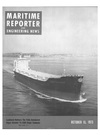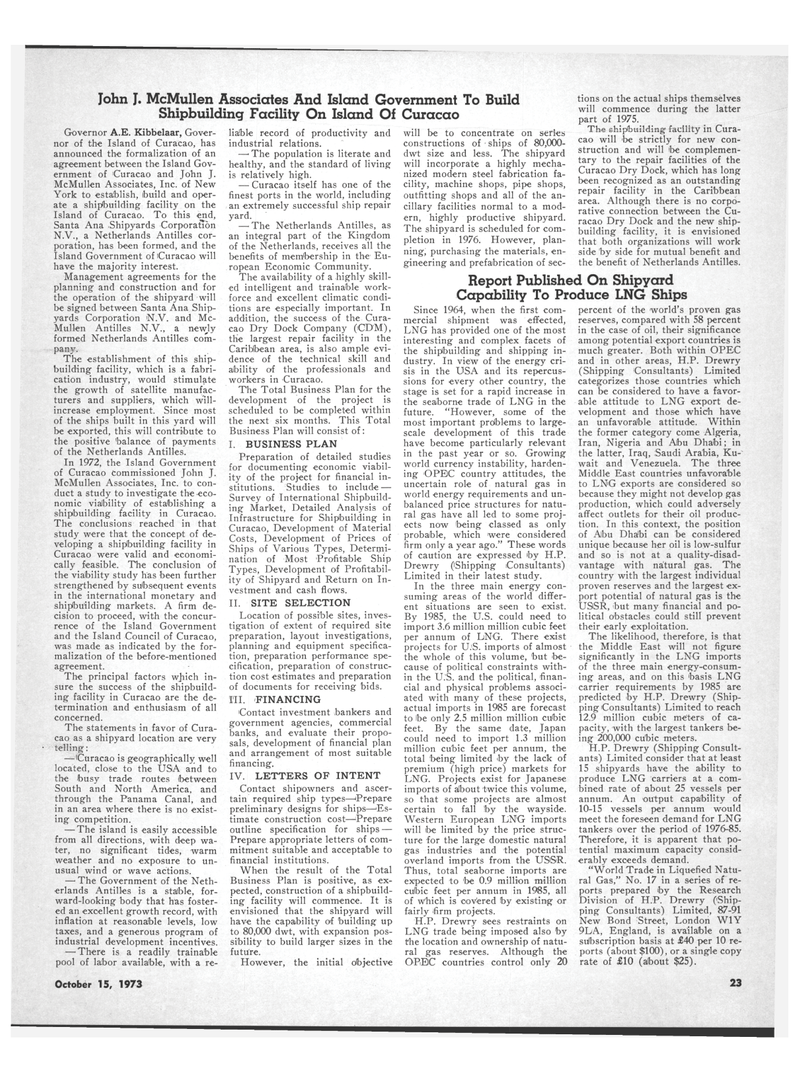
Page 17: of Maritime Reporter Magazine (October 15, 1973)
Read this page in Pdf, Flash or Html5 edition of October 15, 1973 Maritime Reporter Magazine
John J. McMullen Associates And Island Government To Build
Shipbuilding Facility On Island Of Curacao
Governor A.E. Kibbelaar, Gover- nor of the Island of Curacao, has announced the formalization of an agreement between the Island Gov- ernment of Curacao and John J.
McMullen Associates, Inc. of New
York to establish, build and oper- ate a shipbuilding facility on the
Island of Curacao. To this end,
Santa Ana Shipyards Corporation
N.V., a Netherlands Antilles cor- poration, has been formed, and the
Island Government of Curacao will have the majority interest.
Management agreements for the planning and construction and for the operation of the shipyard will be signed between Santa Ana Ship- yards Corporation N.V. and Mc-
Mullen Antilles N.V., a newly formed Netherlands Antilles com- pany.
The establishment of this ship- building facility, which is a fabri- cation industry, would stimulate the growth of satellite manufac- turers and suppliers, which will- increase employment. Since most of the ships built in this yard will be exported, this will contribute to the positive balance of payments of the Netherlands Antilles.
In 1972, the Island Government of Curacao Commissioned John J.
McMullen Associates, Inc. to con- duct a study to investigate the eco- nomic visibility of establishing a shipbuilding facility in Curacao.
The conclusions reached in that study were that the concept of de- veloping a shipbuilding facility in
Curacao were valid and economi- cally feasible. The conclusion of the viability study has been further strengthened by subsequent events in the international monetary and shipbuilding markets. A firm de- cision to proceed, with the concur- rence of the Island Government and the Island Council of Curacao, was made as indicated by the for- malization of the before-mentioned agreement.
The principal factors which in- sure the success of the shipbuild- ing facility in Curacao are the de- termination and enthusiasm of all concerned.
The statements in favor of Cura- cao as a shipyard location are very telling: — 'Curacao is geographically well located, close to the USA and to the busy trade routes between
South and North America, and through the Panama Canal, and in an area where there is no exist- ing competition. — The island is easily accessible from all directions, with deep wa- ter, no significant tides, warm weather and no exposure to un- usual wind or wave actions. —• The Government of the Neth- erlands Antilles is a stable, for- ward-looking body that has foster- ed an excellent growth record, with inflation at reasonable levels, low taxes, and a generous program of industrial development incentives. — There is a readily trainable pool of labor available, with a re- liable record of productivity and industrial relations. —'The population is literate and healthy, and the standard of living is relatively high. — Curacao itself has one of the finest ports in the world, including an extremely successful ship repair yard. —>The Netherlands Antilles, as an integral part of the Kingdom of the Netherlands, receives all the benefits of membership in the Eu- ropean Economic Community.
The availability of a highly skill- ed intelligent and trainable work- force and excellent climatic condi- tions are especially important. In addition, the success of the Cura- cao Dry Dock Company (CD'M), the largest repair facility in the
Caribbean area, is also ample evi- dence of the technical skill and ability of the professionals and workers in Curacao.
The Total Business Plan for the development of the project is scheduled to be completed within the next six months. This Total
Business Plan will consist of:
I. BUSINESS PLAN
Preparation of detailed studies for documenting economic viabil- ity of the project for financial in- stitutions. Studies to include —
Survey of International Shipbuild- ing Market, Detailed Analysis of
Infrastructure for Shipbuilding in
Curacao, Development of Material
Costs, Development of Prices of
Ships of Various Types, Determi- nation of Most Profitable Ship
Types, Development of Profitabil- ity of Shipyard and Return on In- vestment and cash flows.
II. SITE SELECTION
Location of possible sites, inves- tigation of extent of required site preparation, layout investigations, planning and equipment specifica- tion, preparation performance spe- cification, preparation of construc- tion cost estimates and preparation of documents for receiving bids.
III. FINANCING
Contact investment bankers and government agencies, commercial banks, and evaluate their propo- sals, development of financial plan and arrangement of most suitable financing.
IV. LETTERS OF INTENT
Contact shipowners and ascer- tain required ship types—Prepare preliminary designs for ships—'Es- timate construction cost—Prepare outline specification for ships —
Prepare appropriate letters of com- mitment suitable and acceptable to financial institutions.
When the result of the Total
Business Plan is positive, as ex- pected, construction of a shipbuild- ing facility will commence. It is envisioned that the shipyard will have the capability of building up to 80,000 dwt, with expansion pos- sibility to build larger sizes in the future.
However, the initial objective will be to concentrate on series constructions of ships of 80,000- dwt size and less. The shipyard will incorporate a highly mecha- nized modern steel fabrication fa- cility, machine shops, pipe shops, outfitting shops and all of the an- cillary facilities normal to a mod- ern, highly productive shipyard.
The shipyard is scheduled for com- pletion in 1976. However, plan- ning, purchasing the materials, en- gineering and prefabrication of sec- tions on the actual ships themselves will commence during the latter part of 1975.
The shipbuilding facility in Cura- cao will be strictly for new con- struction and will be complemen- tary to the repair facilities of the
Curacao Dry Dock, which has long been recognized as an outstanding repair facility in the Caribbean area. Although there is no corpo- rative connection between the Cu- racao Dry Dock and the new ship- building facility, it is envisioned that both organizations will work side by side for mutual benefit and the benefit of Netherlands Antilles.
Report Published On Shipyard
Capability To Produce LNG Ships
Since 1964, when the first com- mercial shipment was effected,
LNG has provided one of the most interesting and complex facets of the shipbuilding and shipping in- dustry. In view of the energy cri- sis in the USA and its repercus- sions for every other country, the stage is set for a rapid increase in the seaborne trade of LNG in the future. "However, some of the most important problems to large- scale development of this trade have become particularly relevant in the past year or so. Growing world currency instability, harden- ing OPEC country attitudes, the uncertain role of natural gas in world energy requirements and un- balanced price structures for natu- ral gas have all led to some proj- ects now being classed as only probable, which were considered firm only a year ago." These words of caution are expressed by H.P.
Drewry (Shipping Consultants)
Limited in their latest study.
In the three main energy con- suming areas of the world differ- ent situations are seen to exist.
By 1985, the U.S. could need to import 3.6 million million cubic feet per annum of LNG. There exist projects for U.S. imports of almost the whole of this volume, but 'be- cause of political constraints with- in the U.S. and the political, finan- cial and physical problems associ- ated with many of these projects, actual imports in 1985 are forecast to be only 2.5 million million cubic feet. By the same date, Japan could need to import 1.3 million million cubic feet per annum, the total being limited by the lack of premium (high price) markets for
LNG. Projects exist for Japanese imports of aJbout twice this volume, so that some projects are almost certain to fall by the wayside.
Western European LNG imports will be limited by the price struc- ture for the large domestic natural gas industries and the potential overland imports from the USSR.
Thus, total seaborne imports are expected to 'be 0.9 million million cubic feet per annum in 1985, all of which is covered by existing or fairly firm projects.
H.P. Drewry sees restraints on
LNG trade being imposed also by the location and ownership of natu- ral gas reserves. Although the
OPEC countries control only 20 percent of the world's proven gas reserves, compared with 58 percent in the case of oil, their significance among potential export countries is much greater. Both within OPEC and in other areas, H.P. Drewry (Shipping Consultants) Limited categorizes those countries which can be considered to have a favor- able attitude to LNG export de- velopment and those whic'h have an unfavorable attitude. Within the former category come Algeria,
Iran, Nigeria and Abu Dhabi; in the latter, Iraq, Saudi Arabia, Ku- wait and Venezuela. The three
Middle East countries unfavorable to LNG exports are considered so because they might not develop gas production, which could adversely affect outlets for their oil produc- tion. In this context, the position of Abu Dhabi can be considered unique because her oil is low-sulfur and so is not at a quality-disad- vantage with natural gas. The country with the largest individual proven reserves and the largest ex- port potential of natural gas is the
USSR, but many financial and po- litical obstacles could still prevent their early exploitation.
The likelihood, therefore, is that the Middle East will not figure significantly in the LNG imports of the three main energy-consum- ing areas, and on this basis LNG carrier requirements by 1985 are predicted by H.P. Drewry (Ship- ping Consultants) Limited to reach 12.9 million cubic meters of ca- pacity, with the largest tankers be- ing 200,000 cubic meters.
H.P. Drewry (Shipping Consult- ants) Limited consider that at least 15 shipyards have the ability to produce LNG carriers at a com- bined rate of about 25 vessels per annum. An output capability of 10-15 vessels per annum would meet the foreseen demand for LNG tankers over the period of 1976-85.
Therefore, it is apparent that po- tential maximum capacity consid- erably exceeds demand. "World Trade in Liquefied Natu- ral Gas," No. 17 in a series of re- ports prepared by the Research
Division of H.P. Drewry ('Ship- ping Consultants) Limited, 87-91
New Bond Street, London W1Y 9LA, England, is available on a subscription basis at £40 per 10 re- ports (about $100), or a single copy rate of £10 (albout $25).
October 15, 1973 11

 16
16

 18
18
